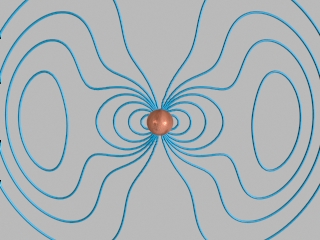 1.2 MEG AVI File
or 1.1 MEG
QuickTime File.
1.2 MEG AVI File
or 1.1 MEG
QuickTime File.
 1.2 MEG AVI File
or 1.1 MEG
QuickTime File.
1.2 MEG AVI File
or 1.1 MEG
QuickTime File.
The field lines of a magnetic dipole for the case where the dipole varies sinusoidally in time by 10% in amplitude (20% peak to peak). That is, the dipole is always oriented along the vertical axis, and its dipole moment varies in time in a manner proportional to (1.0 + 0.1 sin(2 Pi t/T) ).
The animation runs over one period of the oscillation. The radiation terms begin to dominate at about cT. Well inside that distance, the field is quasi-static.
The motion of the field lines is given by the ExB drift motion, which is also the direction (but not the magnitude!) of the Poynting flux. By looking at the motion of the field lines one can see that the energy flow in the quasi-static region is first away from and then toward the origin, as energy is first put into and recovered from the magnetic field. However, in the radiation zone, the energy flow (and field line motion) is consistently away from the origin, representing the irreversible energy loss to radiation.
A 3D representation of this same radiation, but choosing only one field line and replicating it every 15 degrees in azimuth, to give a field for the 3D structure of the field.
70 MHz Dipole Radiation in 26-100 (set player to loop). In this animation we let the dipole moment vary from -1 to 1 sinusiodally, a more realistic animation of radiation from an antenna with an AC feed.